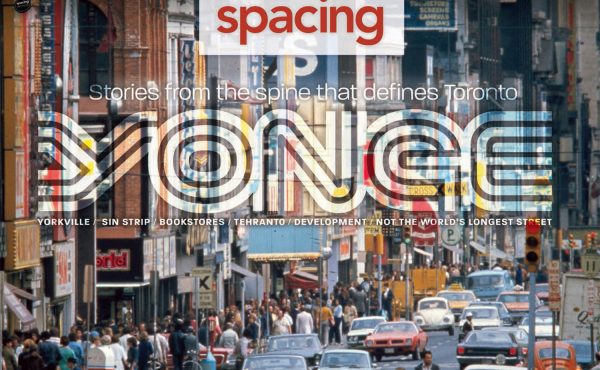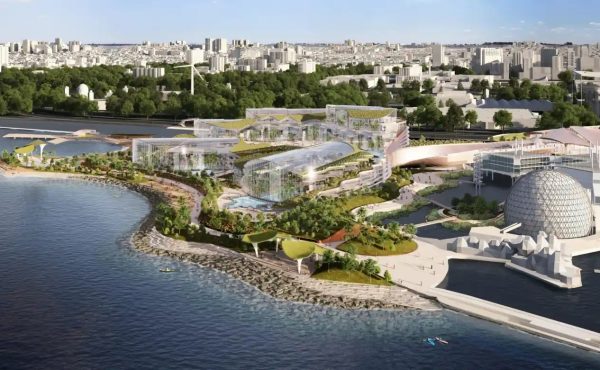
This regular online series will feature interviews with fascinating and influential urban thinkers, with a focus on discussing how Toronto can become a more engaged, accessible, and sustainable city.
Waterfront Toronto, an agency jointly owned by the Federal, Provincial and Municipal governments, is responsible for all aspects related to the planning and development of Toronto’s historically neglected waterfront. Spacing spoke with John Campbell, CEO of Waterfront Toronto, to discuss his organization’s mandate and its track record of success.
Spacing: What does Waterfront Toronto do to facilitate waterfront development?
Campbell: When Waterfront Toronto was created, each government committed $500 million in seed capital to help kick-start the revitalization process. The vast majority of the waterfront land is owned by the governments so they also gave the organization control over this land.
To facilitate waterfront revitalization, Waterfront Toronto works with public and private partners who buy the land for development. Land is tendered competitively and development partners are chosen based on their ability to meet and deliver on a comprehensive list of criteria. Waterfront Toronto’s funding model leverages the public investment by working with private development partners who buy the land for development, and the money earned is used to further fund public infrastructure.
Spacing: What advantages are there to Waterfront Toronto’s coordinated system of planning and development?
Campbell: Waterfront Toronto’s approach is revitalization and not just redevelopment. We take a truly integrated planning and design approach that looks not just at buildings but at all the things that make great cities, such as street networks that link to the rest of the city and scale that fosters a good sense of community, walkability and balancing all modes of transportation. We also emphasize parks and public spaces, and we design in a way that’s environmentally and economically sustainable. Our plans also build on Toronto and Ontario smart growth and healthy city policies and objectives.
Spacing: What kind of experts are employed by Waterfront Toronto and why is such expertise essential to the overall project?
We pride ourselves on having some of the best talent working on the revitalization of Toronto’s waterfront from employees to design consultants to our development partners. We are working with some of the world’s best architects and landscape architects and our employees have a broad range of professional and technical experience including engineers, planners, architects, sustainability experts, financial planners, real estate development professionals all on our roster.
You only get a few chances to do the waterfront of a city and this is our moment to create a waterfront that the people of Toronto want and deserve. It is important that we have the best talent and experts working towards the revitalization of our waterfront to ensure we get it done right.
Spacing: What are some of the more difficult and perhaps time consuming challenges in transforming the Waterfront?
Campbell: If revitalizing our waterfront was easy – it would have already been done. Some of the reasons why it has taken decades to transform Toronto’s waterfront include soil contamination from previous industrial activity that needs to excavated and treated; the lack of servicing and infrastructure to the area; flood proofing as a prerequisite for any development and formerly a lack of governance to develop a comprehensive strategy to leverage tri-government assets.
To make sure the revitalization of Toronto’s waterfront is done right, you have to ensure that you engage and listen to all the stakeholders. For us, this has meant the three orders of government, local community members and the broader community. You also need to have the public investment needed to bring the land to market and bring the private sector to the table.
Spacing: What does the private development community think of Waterfront Toronto?
Campbell: The development community has been very supportive with our plans for waterfront revitalization. We offer the private sector a high level of certainty in undertaking development on the waterfront. We undertake most of the upfront work such as constructing major parks and public spaces, ensuring that zoning and other approvals are in place, building infrastructure such as roads and services, and management of the environmental risks. Developers/builders are left with only the market and construction risk.
Waterfront Toronto has concluded public and private sector development deals valued at $1.475 billion, far exceeding the $900 million public investment spent to date. The planning and approvals work we have done has unlocked the development potential of 65 hectares (160 acres) of land and allows for construction of $10.8 billion in development value.
Spacing: What’s in store for the next 5 years?
Campbell: The next five years promise to be very exciting as we continue transforming Toronto’s waterfront. People will see continued momentum including increased construction activity, development of residential and commercial buildings and more new parks and public spaces opening.
East Bayfront will be a buzz of activity with Sherbourne Common North opening this summer and George Brown College’s new waterfront campus ready for the 2012 fall semester. Sales will also be launched for the Parkside with construction starting in 2012. Design work will continue on Bayside with construction expected to begin in 2013.
People will also see the build-out of the West Don Lands community in time for the Toronto 2015 Pan/Parapan American Games. Construction on the first phase of Urban Capital’s River City project will also begin this year, and occupancy of the first affordable housing development is slated for 2013.
The exciting transformation of the central waterfront will also continue with construction beginning on Queens Quay Boulevard this fall. New public amenities like Underpass Park and Don River Park will be opening in 2012 and construction will begin this summer on phase two of Mimico Waterfront Park and improvements to Tommy Thompson Park.
Spacing: Where can the public learn more about what’s happening on our waterfront?
Campbell: Anyone who is wondering what is happening on Toronto’s waterfront should read our online community report to discover how our waterfront is changing.
Go to www.waterfrontoronto.ca/2011 and view the report to learn about the latest developments.
Photo by Waterfront Toronto





4 comments
1) Big thanks to Spacing for setting up this interview, and to John for participating
2) The current administration at City Hall has expressed a less-than-supportive attitude towards Waterfront development, is there a reason why this wasn’t addressed in the interview?
Thanks 416expat for your comment.
As the interviewer, I can tell you that the less than supportive attitude emanating from City Hall helped inspired this interview. The administration has made some false claims about Waterfront Toronto. They’ve attacked waterfront revitalization as being too slow, not achieving its goals, and above all, that it’s wasting money. A ‘boondoggle’ to use their term. My hope is that readers might benefit hearing directly from the CEO about the essential work that Waterfront TO has undertaken and conclude that their taxpayer dollars are being spent properly.
I have been involved in many of the public consultations organized by Waterfront Toronto and can only say that they have been of exceptional quality. I have been involved in public consultations on development issues in other communities and have never before experienced the level of transparency, thoroughness, financial responsibility, environmental concern, cooperation at all levels, careful choosing of private partnerships, and high standards maintained throughout by WT. The resulting parks and new residential and retail communities will be outstanding and give Toronto a high reputation for business investment, as well as delightful places to live and destinations to visit. My warmest congratulations and support goes to Waterfront Toronto and the wide range of projects being undertaken.
Penelope Tyndale, Member of Gooderham and Worts Neighbourhood Association and Neighbourhood Liaison Representative for Little Trinity Church, King Street E.
I hope that Waterfront Toronto will be able to continue with its exceptional and imaginative work in spite of the less than supportive attitude from the current municipal government.
After years of stalling, the waterfront has become a wonderful example of what can be achieved when a high level of creativity and co-operation from different government levels can work together to produce a high level of design.
Keep up the good work!!!!